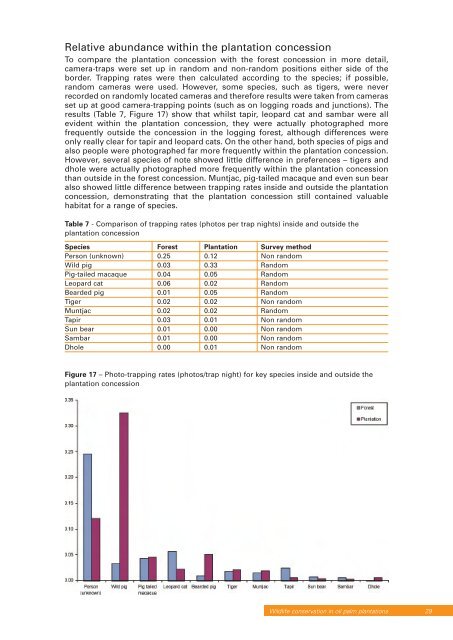The conservation of tigers and other wildlife in oil palm plantations
The conservation of tigers and other wildlife in oil palm plantations
The conservation of tigers and other wildlife in oil palm plantations
Create successful ePaper yourself
Turn your PDF publications into a flip-book with our unique Google optimized e-Paper software.
Relative abundance with<strong>in</strong> the plantation concession<br />
To compare the plantation concession with the forest concession <strong>in</strong> more detail,<br />
camera-traps were set up <strong>in</strong> r<strong>and</strong>om <strong>and</strong> non-r<strong>and</strong>om positions either side <strong>of</strong> the<br />
border. Trapp<strong>in</strong>g rates were then calculated accord<strong>in</strong>g to the species; if possible,<br />
r<strong>and</strong>om cameras were used. However, some species, such as <strong>tigers</strong>, were never<br />
recorded on r<strong>and</strong>omly located cameras <strong>and</strong> therefore results were taken from cameras<br />
set up at good camera-trapp<strong>in</strong>g po<strong>in</strong>ts (such as on logg<strong>in</strong>g roads <strong>and</strong> junctions). <strong>The</strong><br />
results (Table 7, Figure 17) show that whilst tapir, leopard cat <strong>and</strong> sambar were all<br />
evident with<strong>in</strong> the plantation concession, they were actually photographed more<br />
frequently outside the concession <strong>in</strong> the logg<strong>in</strong>g forest, although differences were<br />
only really clear for tapir <strong>and</strong> leopard cats. On the <strong>other</strong> h<strong>and</strong>, both species <strong>of</strong> pigs <strong>and</strong><br />
also people were photographed far more frequently with<strong>in</strong> the plantation concession.<br />
However, several species <strong>of</strong> note showed little difference <strong>in</strong> preferences – <strong>tigers</strong> <strong>and</strong><br />
dhole were actually photographed more frequently with<strong>in</strong> the plantation concession<br />
than outside <strong>in</strong> the forest concession. Muntjac, pig-tailed macaque <strong>and</strong> even sun bear<br />
also showed little difference between trapp<strong>in</strong>g rates <strong>in</strong>side <strong>and</strong> outside the plantation<br />
concession, demonstrat<strong>in</strong>g that the plantation concession still conta<strong>in</strong>ed valuable<br />
habitat for a range <strong>of</strong> species.<br />
Table 7 - Comparison <strong>of</strong> trapp<strong>in</strong>g rates (photos per trap nights) <strong>in</strong>side <strong>and</strong> outside the<br />
plantation concession<br />
Species Forest Plantation Survey method<br />
Person (unknown) 0.25 0.12 Non r<strong>and</strong>om<br />
Wild pig 0.03 0.33 R<strong>and</strong>om<br />
Pig-tailed macaque 0.04 0.05 R<strong>and</strong>om<br />
Leopard cat 0.06 0.02 R<strong>and</strong>om<br />
Bearded pig 0.01 0.05 R<strong>and</strong>om<br />
Tiger 0.02 0.02 Non r<strong>and</strong>om<br />
Muntjac 0.02 0.02 R<strong>and</strong>om<br />
Tapir 0.03 0.01 Non r<strong>and</strong>om<br />
Sun bear 0.01 0.00 Non r<strong>and</strong>om<br />
Sambar 0.01 0.00 Non r<strong>and</strong>om<br />
Dhole 0.00 0.01 Non r<strong>and</strong>om<br />
Figure 17 – Photo-trapp<strong>in</strong>g rates (photos/trap night) for key species <strong>in</strong>side <strong>and</strong> outside the<br />
plantation concession<br />
Wildlife <strong>conservation</strong> <strong>in</strong> <strong>oil</strong> <strong>palm</strong> <strong>plantations</strong> 29

















